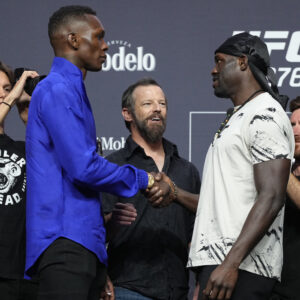WIMBLEDON, England — It is about tradition this year at Wimbledon on the 100th anniversary of Centre Court, but as the defending men’s singles champion Novak Djokovic walked back onto the grass on Monday to launch this year’s tournament, it was also about change.
There is plenty of it at the All England Club in 2022: large and small; obvious and subtle.
The big stuff: Russian and Belarusian players (and journalists) have been barred because of Russia’s invasion of Ukraine. The tournament has been expanded from 13 days of play, with no matches scheduled on the first Sunday, to a full 14 days that will leave no respite for the grass and the leafy neighborhood.
The little stuff: The benches and desks in the Centre Court press seats have been replaced with padded chairs. All England Club members with their circular purple badges no longer serve as moderators at news conferences. Now, the stars sit alone at the rostrum, as they do nearly everywhere else in the tennis world.
As if to underscore the theme, Djokovic and his first-round opponent, Kwon Soon-woo, arrived on the most celebrated court in tennis in novel fashion.
Players have long exited the clubhouse and made a hard left, passing behind a screen with a club member leading the way, before taking a hard right and stepping onto the grass.
Beginning this year, they walk straight ahead and unaccompanied out of the clubhouse and onto the court through a new set of green doors that are quickly closed behind them.
It seemed unceremoniously abrupt to those used to the old ways and fond of the murmurs from the crowd that used to build into cheers as the players navigated the passageway before coming fully into public view.
But the pixie dust was still there, as Djokovic confirmed after his 6-3, 3-6, 6-3, 6-4 victory, which seemed even closer than the score.
“Childhood dreams were realized here in 2011,” Djokovic said of the first of his six Wimbledon singles titles. “I will never forget that. It will always have a special place in my heart. Of course, every time I step out there on the court, there is this goose bumps type of feeling, butterflies in the stomach.”
It happens the first time, too, as Emma Raducanu later confirmed. All in a rush last year, she became a global star and a superstar in Britain by winning the U.S. Open at age 18, becoming the first player to win a Grand Slam singles title as qualifier. Victories have been much harder to come by since then, but she already had fine memories of Wimbledon after reaching the fourth round in her first appearance in the main draw last year.
Monday, however, was her first match on Centre Court, and though she has barely played on grass this season because of injuries, she managed the moment, and a tricky opponent in Alison Van Uytvanck, to win 6-4, 6-4.
Raducanu may not be ready to take over women’s tennis. No. 1 Iga Swiatek, who just turned 21, has taken up that air and space. But Raducanu clearly knows how to rise to an occasion.
“From the moment I walked out through those gates, I could really just feel the energy and the support and everyone was behind me from the word ‘go,’” she said. “I just really tried to cherish every single point on there, played every point like it could have been one of my last on that court.”
That was imaginative thinking indeed, considering that Raducanu, Britain’s first women’s Grand Slam singles champion since Virginia Wade in the 1970s, is poised to be a Centre Court fixture for a decade or more if she can remain healthy.
Andy Murray knows the drill. He, too, became a Centre Court regular in his teens and eventually lived up to the billing by ending a 77-year drought for British men in singles by winning Wimbledon in 2013 and again in 2016.
Playing with an artificial hip at age 35, Murray has proved his love of his craft beyond a reasonable doubt. Though he will never bridge the achievement gap that separates him from the Big Three of Djokovic, Rafael Nadal and Roger Federer — each with 20 or more major singles titles — Murray remains a threat on grass on any given afternoon.
He demonstrated it with a 4-6, 6-3, 6-2, 6-4 victory over James Duckworth that closed play on Centre Court on opening day, almost exactly eight hours after it had begun and almost exactly 100 years after the first opening day on Centre Court.
That was on June 26, 1922, after the All England Lawn Tennis and Croquet Club moved from its cozier, original home on Worple Road after purchasing land on Church Road to accommodate a new, larger stadium. The main court at Worple Road had been called Centre Court because it was actually at the center of the grounds. The club kept the name even though the new primary court was no longer so central.
The new Wimbledon got off to a soggy start with rain and more rain, forcing the 1922 edition to finish on a Wednesday, but it was still a popular success with worthy singles champions: the stylish and long unbeatable Frenchwoman Suzanne Lenglen and the Australian men’s star Gerald Patterson, a two-time Wimbledon champion nicknamed “The Human Catapult” because of his big serve (he could volley, too).
Both Lenglen and Patterson would have been in for a few surprises if they had been watching on Monday. Centre Court is now rainproof with its retractable, accordion-style roof that was put to good use for Djokovic’s and Kwon’s duel.
The electronic scoreboards and the touch screen operated by the chair umpire would also have caught their eyes, as would the once-unthinkable fact that the chair umpire for Monday’s opening men’s match was a woman: Marija Cicak.



